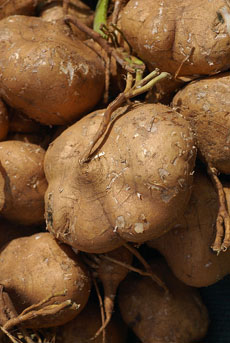TIP OF THE DAY: Jícama
|
If you hadn’t read the headline, would you be able to name this vegetable?
Botanists might call it Pachyrhizus erosus, but we know it as jícama (HEEK-uh-muh) or alternatively, the Mexican yam or Mexican turnip, although, as it is so often in popular nomenclature, jicama is not related botanically to either the yam or the turnip (except that are tree all root vegetables). The flowering vine is native to Mexico; it is the tuberous root of the plant that is eaten. You’ll find it most often in Latin American cuisine, although Spanish traders brought it to the Philippines, from which it was brought to China and other parts of Southeast Asia. It‘s now an ingredient in popular dishes of Indonesia, Malaysia, and Vietnam. Jícama is white and crunchy, not unlike a water chestnut. The flavor is mild, sweet, and starchy—like some apples that aren’t sweet enough. Some people liken the flavor to raw green beans. |
Jicama: tuberous roots. Photo by Eric | Wikimedia. |
|
|
Jícama’s best use is to add crunch to salads, salsas, and slaws, or to join in with other crudités. At 86%-90% water, it’s a hydrating snack on a hot day. (Jícama is high in vitamins A, some Bs, and C, calcium, and phosphorus.) The jícama at most grocery stores is coated with a thick wax, for extended shelf life. The yellow, papery skin is first peeled with a paring knife, revealing flesh that looks like a potato. It can then be diced into cubes or sliced into matchsticks or batons. Uncut jícama can be stored at room temperature for a week or so, or refrigerated a bit longer. Once cut, it should be wrapped in plastic and refrigerated, where it will last for another week. |
||
 Jícama fries. Photo courtesy Annaliisa’s Organic Kitchen. Here’s the recipe. |
HOW TO SERVE JÍCAMA
Once you’ve peeled a jícama, what do you do with it? Save a few slices for your salad! |
|
|
CHECK OUT WHAT’S HAPPENING ON OUR HOME PAGE, THENIBBLE.COM.
|
||



